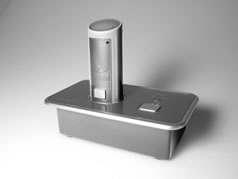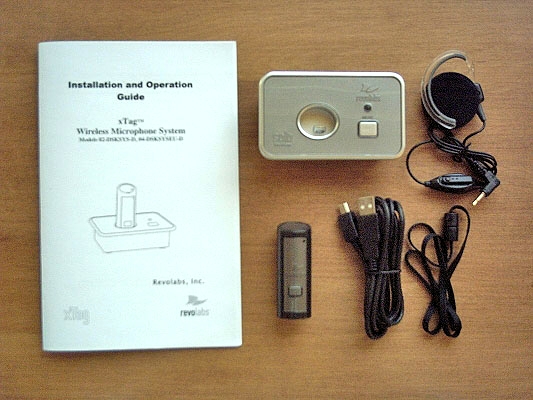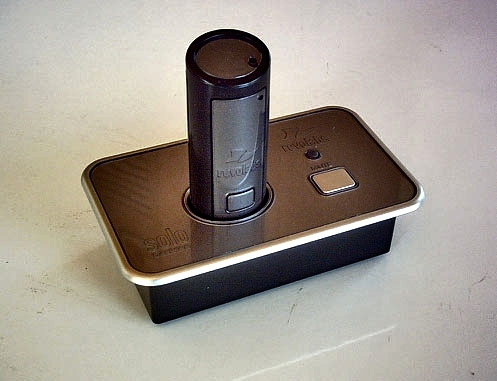‘Book Mystique Review: Revolabs xTag USB Wireless Microphone
Wednesday, November 12, 2008
by Charles W. Moore
I;m gradually joining the wireless revolution. My current favorite computer mouse is the Logitech V550 Nano Cordless Laser Mouse, I also like Logitech’s stunning diNovo Keyboard, Mac Edition, which is wireless and has a rechargeable internal battery, and when broadband Internet finally reaches this neck of the woods, promised by the end of 2009, it will be wireless as well.
I’ve also been checking out a wireless microphone, MacSpeech, developers of the Dictate and former iListen dictation and computer control software for the Mac, also sells a couple of different wireless microphones approved for use with their software products, one of which is the Revolabs xTag Wireless Lapel Microphone.

The beauty of a wireless mic is of course that it untethers you to roam freely as you dictate into iListen, voice chat online, record Podcasts, or talk on the phone using VOIP
MacSpeech says that the xTag is an appropriate choice for anyone who works in a quiet environment and would like a good wireless solution. but cautions that those who are more soft spoken may require more effort to achieve higher accuracy levels, although that it is possible over time. Revolabs claims the xTag’s noise canceling properties will not pick up keyboard clicks, chair squeaks, or a laser printer from 3 feet away or someone talking on a telephone from 8 feet away. I’m fairly soft-spoken, but my work environment is pretty quiet most of the time, and the Xtag mic works well in that regard for me.
The Revolabs xTag USB wireless Microphone setup is a wireless communications system operating at 100 - 8000 Hz and supporting high bandwidth audio that enables secure, untethered personal communication. Happily, it connects to any computer running Mac OS X or Windows XP or Vista via USB without requiring a software driver install.
About the size and shape of a (fat) lipstick tube, this noise-canceling microphone interfaces with a base station is about the size of two iPods stacked on top of one another and connects to a USB port. The microphone itself clips to your collar or lapel. The base station/charging tray is the communications hub and charging dock of the xTag Desktop. This compact unit controls all communication flow of the xTag Desktop system.
The xTag microphone features 1.98 GHz DECT technology, which among other things, means it can coexist with other wireless products such as Airport networks and cellular phones, eliminating the unwanted noise these devices can cause.
The xTag system product bundle includes the charger base station, the wearable xTag wireless microphone module, a clip-on earpiece with volume control, a quick-release lanyard for wearing the mic around your neck, a USB charge and connection cable, an Installation and Operation Guide, and xTag quick start guides.

The microphone requires operating system support for USB audio, and a USB port capable of supplying 500mA of current; ergo, it will not work with unpowered USB hubs.
On a Macintosh, installation really couldn’t be simpler. While the product’s Installation and Operation Guide devotes more than four pages to the fun and adventure of getting the microphone set up with Windows XP, on the Mac you can ignore all that because it is essentially a plug and play proposition. It would be helpful if this point were emphasized more strongly in the Guide, but it isn’t, and indeed the Mac OS or any OS other than XP are not mentioned at all, which may be a bit disconcerting to some Mac users. But we’re used to that, aren’t we? And the payoff once again is that the product “just works” on the Mac with no muss or fuss. Another reason to thank yourself for using a Mac.
All that was necessary for me to do was to run the “Set Up My Microphone” routine in iListen’s Speech menu (i’m still using iListen 1.8 because Dictate doesn;t support PowerPC and I have yet to upgrade to MacIntel), which takes about three minutes, and I was good to go.
However, before using the microphone for the first time, it was also necessary to charge it for approximately 8 hours or overnight in the charger base until the LED indicator the microphone turns solid Green. As noted, a USB cable is provided for connection to a computer.
The charging cycle indicator and the microphone status LED indicator both change from solid red to solid green when the charge is complete. The charge status indicator remains off during charging. The microphone is always automatically muted when it is inserted in the charger base. Once the initial charge has been done, the battery will normally charge from fully depleted to fully charged in approximately 2 hours, although it can be “quick charged” to about 80 percent capacity and about 45 minutes. A fully charged battery will provide approximately eight hours of talk time.

When the microphone needs recharging, the LED will start flashing alternating red and yellow or yellow and green. As the battery ages however, ( over a period of years) Revolabs says it will gradually require charging after shorter periods of time. Unfortunately, the lithium polymer rechargeable battery that powers the xTag microphone is not user serviceable. If you need service, visit the Revolabs knowledge base Web site area at:
http://www.revolabs.com
The xTag wireless microphone module uses encrypted communications to synchronize with the charger base. The xTag microphone can be worn in your pocket, on your lapel, or on a lanyard, and provides high quality full duplex audio between the user and the computer and/or the Internet phone system.
In order to use the microphone, remove it from the charger base. The unit will automatically turn on and mute, displaying a flashing red LED when it is removed from the base.
The wireless microphone module has a clip on its back which allows it to be easily fastened through to shirt pocket or lapel. The microphone can also the attached to a lanyard, which is supplied, and worn around the neck. I found the lapel mount suited me best. The microphone should be attached as closely as possible to your mouth, within six to 12 inches is ideal.
Once the microphone is properly positioned, un-mute it by pressing and releasing the Mute button. The flashing LED will change to green on both the microphone and charger base to confirm the microphone is now active.
When you’re finished using the microphone, simply unclip the mic module from your clothing and return it to the charger base. The microphone’s LED will show a five second self-test pattern. Alternatively, you can turn off the microphone manually by pressing and holding the Mute button for approximately 10 seconds, until the LED turns solid Red, at which point you release the button.
The xTag Wireless Microphone has a maximum range of approximately 65 feet or 20 meters, which should be more than adequate for dictation work, but you might test that limit if you were using the mic for telephony. If you happen to move out of range, the connection between the charger base and microphone will be dropped and the microphone will mute (the LED will flash alternating red and green). If the microphone is moved back within range within 15 minutes the connection will automatically be reestablished to its original state. If not, the microphone will turn off after five minutes.
It is possible to adjust the broadcast power between the microphone and its charger base to three different levels if required for use in areas where multiple wireless devices are being used. The highest power level, which is the default, provides 60 feet (25 meters) maximum operating distance between the microphone and its base.
There is also a medium power level supporting 20 feet (7 meters) range, and a low power level providing six feet (2 meters) maximum operating distance between the microphone and the base. For instructions on how to reset the broadcast power level, consult the Installation and Operation Guide.
Another supported feature is “pairing” which refers to an encrypted association between the wireless microphone and its charger base with a unique electronics serial number. Once the microphone and charger-base have been paired, the microphone will automatically try to connect to the base whenever it is lifted from the base.
So what’s it like to use in practice? I found that I really like this little xTag microphone, which works well and is very convenient. I’m less smitten with the peripheral earpiece, which is monaural, has to be clipped to your ear (it is quite secure once affixed), and has a wire cord with an inline volume control module that must be plugged into the microphone module, which cancels out some of the “untetheredness” factor with added complexity. I opted mostly to just use the speaker in the PowerBook, but of course a private earphone for playback will be desirable or necessary in certain work environments.
To adjust the volume on the earpiece, use the thumbwheel dial on the volume control module. The microphone’s volume is not adjustable, although it may be possible to change volume settings in your software on the computer. Moving the microphone closer to your mouth will effectively increase the input volume.
I found the Revolabs xTag Wireless Microphone gives very decent accuracy, perhaps not quite up to the standard of the VXi Parrot TalkPro wired mic I generally use, but still quite acceptable. According to MacSpeech spokesman, in formal testing,\ the TalkPros get better accuracy, with the xTag is rated “2 thumbs” while the $100 more expensive Samson Airline 77 Wireless mic also sold by the MacSpeech Store and the wired TalkPros are rated “3 thumbs”.
And I can understand why. I had never used a wireless mic before, and I took to it more than I had anticipated I would. It actually helps the creative juices to flow more freely when composing, I think. There is something constraining and inhibiting about being tethered to a wire, and I mean in more than the obvious literal sense. The xTag Wireless Microphone frees you from this.
The xTag modules are attractively finished with a quality appearance, although the overall styling effect is a bit utilitarian for those of us used to the elegance of Apple products. However, this mic system works well with no hassle, which is the most important thing.
xTag Wireless Microphone Key Features
• Ease of Use
The xTag USB Desktop is a plug-and-play personal microphone that is instantly recognized by all operating systems and immediately usable out of its box.
• Comfort
The small form factor and wireless capability combined with the lack of a headset, makes the xTag USB Desktop an attractive and comfortable alternative.
• Rechargeable Battery
The rechargeable battery provides eight hours of talk time after each charge. The unit will be charged any time the USB cable is connected.
• High Quality
Recording/Voice Lift Capability: The xTag USB Desktop provides high quality input for dictation, VOIP, Internet Telephony, Webconferencing and Recording via its state-of-the-art noise-canceling technology.
Benefits
• Nothing beats the look, comfort of an xTag because it’s a lapel microphone.• No headset means you look more professional when when dictating, especially in front of clients / customers / patients.
• Excellent accuracy.
• 8 hour talk time.
• Charges from any USB port.
• Great noise cancellation for a lapel microphone. This microphone will not pick up keyboard clicks, chair squeaks, laser printer from 3 feet away or someone talking on a telephone from 8 feet away.
• 128 bit encryption
• Includes remote dual function Mute and On/Off switch.
Dimensions, (L,W,H) and Weight
Charging Base
3.9” (10cm) W x 2.4” (6cm) D x 1.0” (2.56 cm) H
.5lbs (.2 kg)
Wireless Microphone
.9” (2.4cm) W x .8” (1.95cm) D x 2.6” (6.68cm) H
.05 lbs (.02 kg)
Accessories
Earpiece – 2.5mm mono audio connector, 26” (66cm) cable with in-line volume control, adjustable earpiece containing a 20mm high quality 32 ohm speaker, easy to clean.
Lanyard – 24” (61cm) of 3/16th (5mm) black rayon fiber with quick disconnect snaps.
Price: $249.00
For more information, visit:
http://www.macspeech.com/product_info.php?cPath=21&products_id=563
Note: Letters to PowerBook Mystique Mailbag may or may not be published at the editor's discretion. Correspondents' email addresses will NOT be published unless the correspondent specifically requests publication. Letters may be edited for length and/or context.
Opinions expressed in postings to PowerBook Mystique MailBag are owned by the respective correspondents and not necessarily shared or endorsed by the Editor and/or PowerBook Central management.
If you would prefer that your message not appear in PowerBook Mystique Mailbag, we would still like to hear from you. Just clearly mark your message "NOT FOR PUBLICATION," and it will not be published.
CM